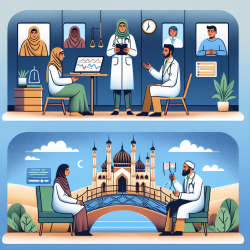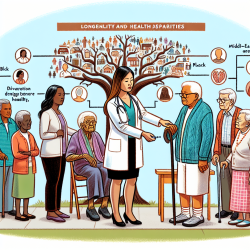Introduction
As a practitioner in the field of special education, staying abreast of the latest research can significantly enhance your therapeutic skills. The recent study titled "Multipoint genome-wide linkage scan for nonword repetition in a multigenerational family further supports chromosome 13q as a locus for verbal trait disorders" offers valuable insights that can be applied to improve therapy outcomes for students with verbal trait disorders.
Understanding the Research
The study focuses on verbal trait disorders, which include deficits in speech, language, reading, spelling, and writing. These disorders can significantly impact a student's ability to communicate effectively. The research highlights nonword repetition (NWR) as a robust endophenotype for verbal trait disorders, sensitive to cognitive processes crucial for verbal development.
Through genome-wide multipoint variance component linkage analysis, the researchers identified a significant region on chromosome 13q14–q21, reinforcing its role as a locus for verbal trait disorders. This discovery aligns with previous findings linking this region to specific language impairments and reading disabilities.
Applying Research Findings to Practice
As a practitioner, understanding the genetic underpinnings of verbal trait disorders can inform your approach to therapy. Here are some ways to integrate these findings into your practice:
- Personalized Therapy Plans: Recognize that genetic factors may influence a student's response to therapy. Tailor interventions to address specific cognitive processes, such as auditory processing and phonological working memory, which are critical for language development.
- Early Identification and Intervention: Use NWR tasks as a tool for early identification of students at risk for verbal trait disorders. Early intervention can mitigate the long-term impact of these disorders on academic and social outcomes.
- Collaborative Approach: Work closely with geneticists and researchers to stay updated on the latest developments in the genetics of verbal trait disorders. Collaboration can lead to more effective, evidence-based interventions.
Encouraging Further Research
The study's findings open avenues for further research into the specific genetic factors contributing to verbal trait disorders. As a practitioner, consider participating in or supporting research initiatives that explore these genetic links. Your involvement can contribute to a deeper understanding of these disorders and the development of more targeted therapies.
Conclusion
Integrating genetic research into your practice can enhance your ability to support students with verbal trait disorders. By personalizing therapy plans, focusing on early intervention, and collaborating with researchers, you can improve outcomes for your students. To delve deeper into the research, read the original paper: Multipoint genome-wide linkage scan for nonword repetition in a multigenerational family further supports chromosome 13q as a locus for verbal trait disorders.










